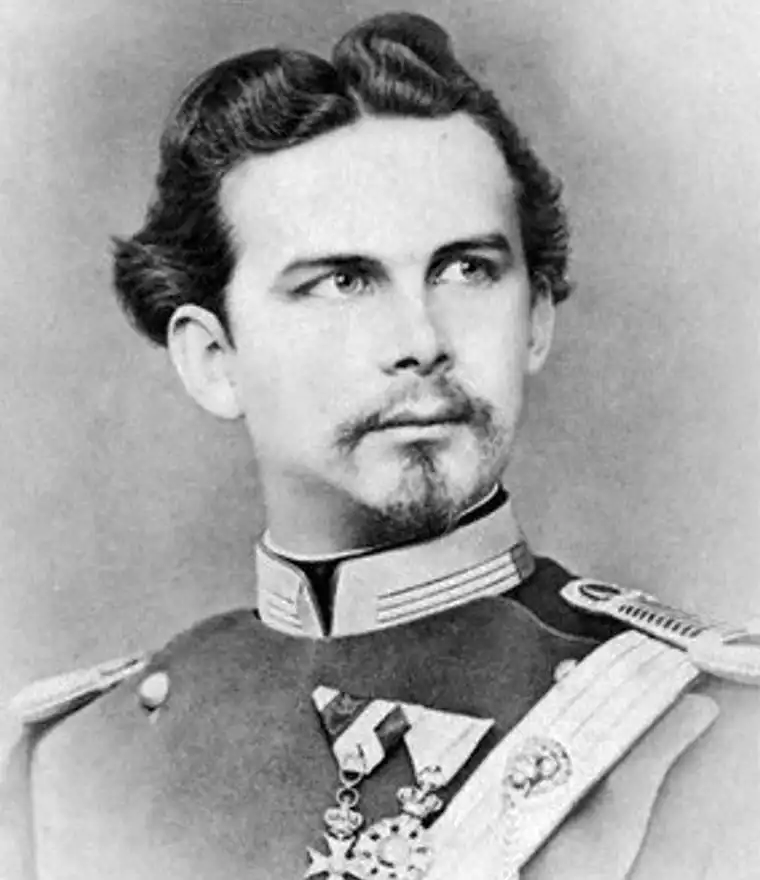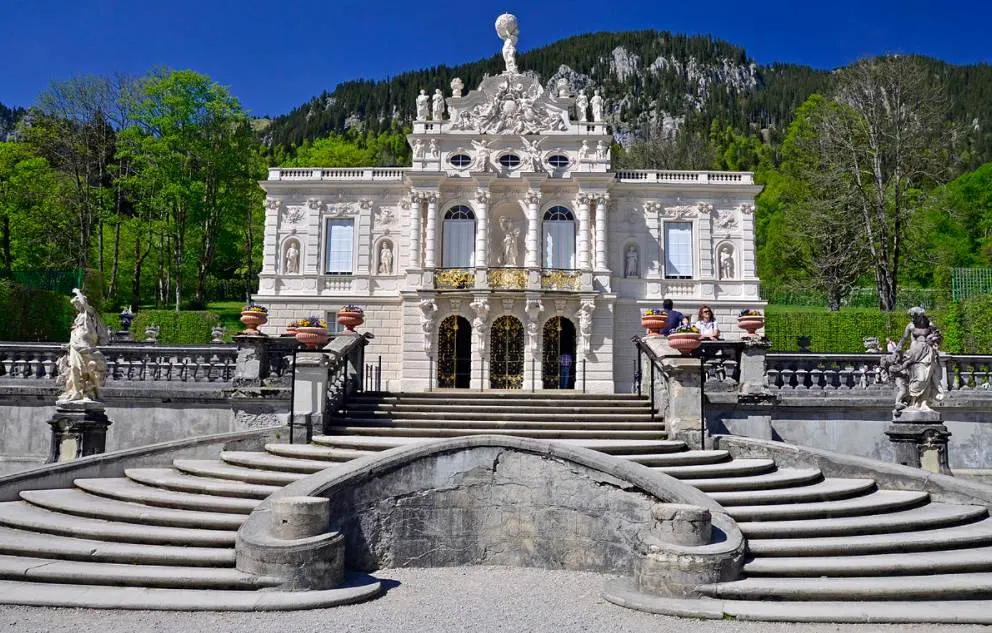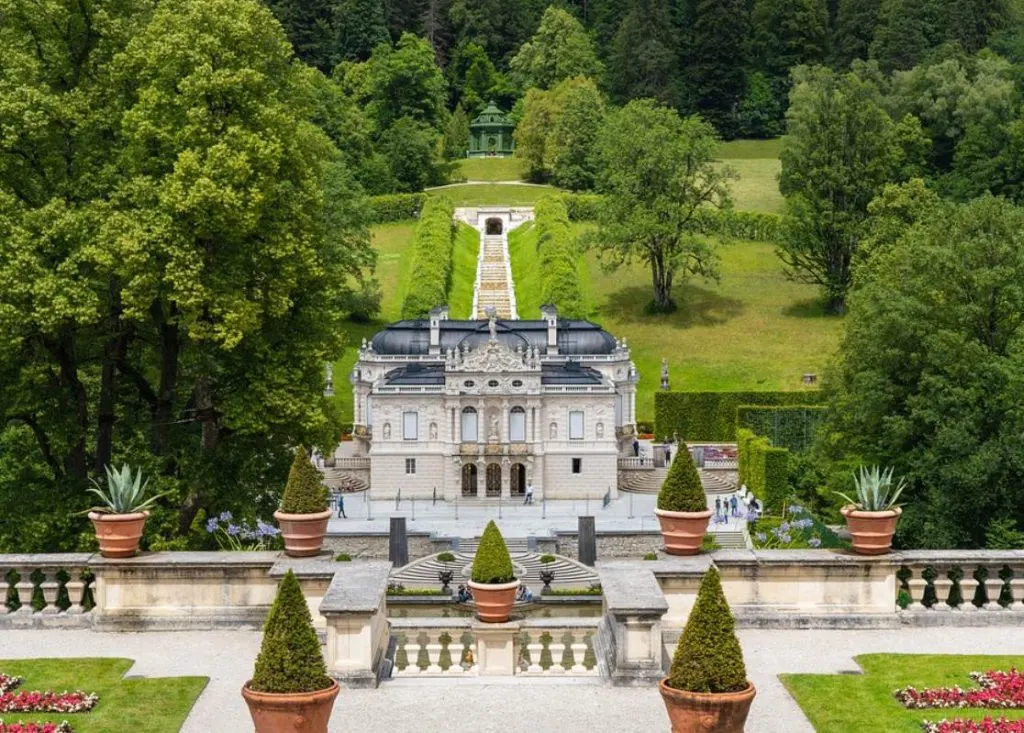Although Rococo architecture emerged in France during the first half of the 18th century, the asymmetric decorations of this exuberant style started being integrated into structures all across Europe shortly after.
One of the most stunning examples of this particular style can be found in the southern part of Germany. In this article, you’ll discover some of the most interesting facts about Linderhof Palace, a stunning Schloss with some interesting stories to tell.
1. It’s located in a small village in the southwest of Bavaria
Linderhof Palace is one of the most famous palaces in Germany. It’s located in the small village of Ettal in the southwestern part of Bavaria, a German state in the southeast of the country.
This town is situated just a few kilometers north of the popular German ski resort Garmisch-Partenkirchen. The castle itself is located just a few kilometers west of the town in this mountainous pre-Alps landscape.
One of the most amazing castles in Europe can be found in this region here as well because Neuschwanstein Castle is located at a similar distance east of Linderhof Palace.

2. The palace was commissioned by the King of Bavaria in the 1860s
The palace was commissioned by King Ludwig II of Bavaria (1845-1886), a man who rose to the throne of the Kingdom of Bavaria in 1864 at the age of 18.
The Bavarians sided with the Prussians during the Franco-Prussian War of 1870 and after their victory, it became part of the German Empire. Despite this notion, Bavaria retained a certain level of autonomy and continued to have its king.
This meant that Ludwig had to spend less time on state affairs and had more time to fulfill his dream of building several castles and palaces. Neuschwanstein Castle was one of these castles, and Linderhof Palace was one of the palaces.
The palace was built on the location of a former structure called the “Königshäuschen” which he had inherited from his father. He started this project in 1869 and the palace was largely completed in 1878.

3. It was the only of the 3 structures that was completed during the king’s life

The construction fever of Ludwig II knew no boundaries. Inspired by the operas of Robert Wagner, something that allowed him to enter the fictional Romantic world of medieval knights.
He commissioned Neuschwanstein Castle and Linderhof Palace while he was still in his twenties and the immense Herrenchiemsee in the year 1878.
Spending so much money on these projects resulted in his demise. He was deposed as King of Bavaria in 1886 and was found dead in a lake near Berg Castle shortly after.
The official version was that he drowned in the lake, despite being a good swimmer. No water was found in his lungs as well, something that makes historians generally agree that he was murdered by his opponents.
Linderhof Palace was the only structure that he lived to see completed.

4. It was partially inspired by one of the most famous palaces in the world
One of the greatest idols of King Ludwig II was Louis XIV, the Sun King of France who enjoyed full power in his absolute monarchy. This was exactly what Ludwig was after and what he tried to emphasize with his building projects.
This also means that the building was partially inspired by the opulent Palace of Versailles near Paris, the epitome of immense palaces all around the world.
Linderhof Palace is substantially smaller and its design closely resembles the Rococo structures built by Louis XV, the successor of Ludwig’s main idol.
The staircase leading up to the palace is a smaller replica of the Ambassador’s staircase at the Palace of Versailles. The unfinished Herrenchiemsee was intended to be a true scaled replica of the famous palace in France.

5. The palace is surrounded by one of the world’s most beautiful gardens
The landscape surrounding the palace is one of the most amazing-looking sceneries imaginable. The formal garden of the palace is divided into 5 different sections and covers an area of 50 hectares (125 acres).
Multiple features inside this garden were added after the palace was already completed, including:
- Venus Grotto – A building that was meant to recreate the effect of the Blue Grotto in Capri.
- Hunding’s Hut – A place to hold German festivities.
- Gurnemanz Hermitage – A wooden chapel where the king came to pray on Good Friday.
- Moorish Kiosk – A structure that was originally built for the International Exhibition in Paris 1867.
- Moroccan House – A Structure that was built for the International Exhibition in Vienna 1873.
Apart from these features, the garden features multiple fountains and is decorated with allegorical sculptures related to the continents, the seasons, and the elements.

More interesting facts about Linderhof Palace
6. When Ludwig II became the King of Bavaria in 1864, he was just 18 years old. This was a period that he still had vivid memories of the hunting trips with his father in the Bavarian Alps.
He started enlarging the Königshäuschen in 1869 but eventually decided to demolish it to construct the much larger Linderhof Palace on this location.

7. Between 1863 and 1886, the astounding amount of 8,460,937 marks was spent on both the structure and garden of the Linderhof Palace.
This is especially amazing because this wasn’t the only project of the king as he simultaneously constructed Neuschwanstein Castel and Herrenchiemsee among various other construction projects.
The result was that he was 14 million marks in debt by 1885, the year before he was deposed of and presumably murdered by his opponents.
8. The interior of the palace is just as opulent as the magnificently decorated exterior of the building. It was designed in a period that is referred to as Rococo Revival, a time that the frivolous movement became popular again.
Only 4 of the rooms inside the relatively small building (compared to other palaces worldwide) have a specific function. Other rooms, such as the two tapestries rooms were just integrated to impress and emphasize the king’s power.

9. One of the rooms inside the palace that had a function was the dining room. The king enjoyed dining alone but the table was still laid for at least 4 people.
The man was obsessed with running an absolute monarchy, but the ideals of King Louis XIV were long gone since the French Revolution.
He, therefore, had imaginary conversations with invisible guests such as Louis XV, Madame de Pompadour, or Marie Antoinette inside this dining room.
10. Although something was clearly wrong with King Ludwig II, his projects have become some of the most popular tourist attractions in Bavaria.
Neuschwanstein Castle is arguably the most famous Romantic building in the world and Linderhof Palace is a popular attraction in the region as well.
It’s one of the 45 palaces, castles, and residences that is managed by the Bavarian Palace Administration, a government institution of the Free State of Bavaria.

